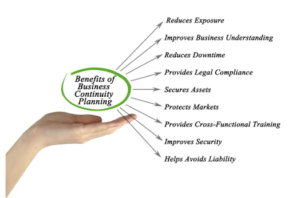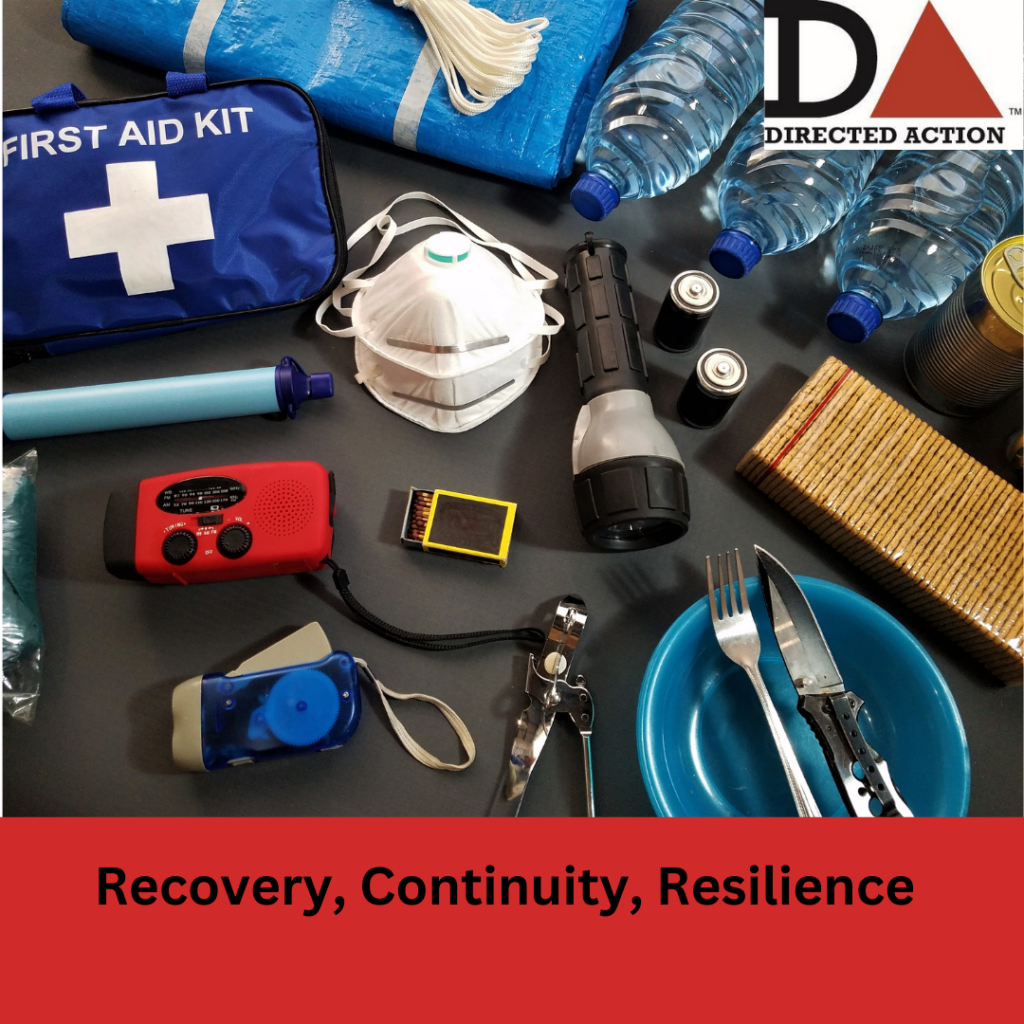Resilience Planning is the Key to Thriving Through a Crisis
The Fed attributes 200,000 business closures to COVID which are lower than some estimates but still quite serious to the owners and employees of those businesses. Some companies have made it through the last two years but did not soar. They are keeping afloat, but barely. At the same time, we know several companies who have thrived despite, or even because of, the changing business environment.
What is the difference between these last two groups – the ones who survived and the ones who thrived? They illustrate an important difference between business continuity and business resilience. Recognizing that difference is important for those surviving businesses, so they don’t become a casualty of the next crisis.
Directed Action recently had the opportunity to lead a group of small businesses through a 2-part business continuity and resiliency training hosted by WBEC West and sponsored by Southern California Edison. Attendees learned about the importance of planning ahead and together we walked through specific situations for attendees. Sharing our insights was truly gratifying and we’ve captured some of the key concepts below along with some quick ways a small business owner can get started using their business resilience muscles.

Key takeaways from the WBEC West, Wells Fargo, and Directed Action Business Resilience training
Overview: What is business continuity/resilience/disaster planning?
Business continuity is the ability to maintain business operations when faced with a business disruption. The disruption could be limited to the company’s operations – like a targeted cyber attack – or it could be global like a pandemic. A company with a business continuity plan in place during COVID 19 may have pivoted to take out orders or had the infrastructure for workers to go remote. They knew how to keep the lights on and the doors open so the basic business operations could continue to function. These shifts were necessary for businesses to survive and in many cases did keep them alive.
For some of them, though, these business continuity plans were short term plans. While they were able to keep the lights on, there were other costs in the form of burnout from working longer hours, or fraying company culture due to lack of connection.
Business resilience, on the other hand, describes a company that can strategically adapt in a rapidly changing situation or business environment so the company is able to thrive and expand. Companies with a business resilience plan in place were able to keep their operations running while identifying new opportunities. These companies not only maintained their company culture but also strengthened it.
Change and uncertainty are inevitable in business. Having not only a continuity plan, but a resilience plan is essential.
What do a grocery chain in Texas and a refugee organization in Ukraine have in common?
Now that we’ve established the difference between a business continuity plan and business resilience plan – who is doing business resilience well? A couple of noteworthy recent examples are H-E-B, a grocery chain in Texas and World Central Kitchen, a non-profit organization that feeds refugees around the world and has proven to be a hero in Ukraine.

Scenario Planning
If you live in Texas, you’ve likely heard about H-E-B responded to COVID-19. Their impact on their local communities has been heralded by news outlets and celebrities like Arnold Schwarzenegger and Mark Wahlberg. They were ahead of other grocery chains in enacting health measures and increasing wages for their staff who became front-line essential workers.
They were able to act quickly because, in February when COVID-19 was just emerging, they did a scenario planning exercise to identify actions they could take when the pandemic came to Texas. The outcome was that when COVID-19 did bring disruptions and closures to Texas a few months later, H-E-B was ready. But their commitment to scenario planning was not isolated to just this event. H-E-B has been working to mitigate the impacts of extreme climate events since 2005 when Hurricane Rita hit Texas. They have built not only a solid business resilience plan but a culture of business resilience that allows them to respond to future threats before they threaten.

Scaling Up
When Russia invaded Ukraine earlier this year, World Central Kitchen (WCK) mobilized to be the first organization providing refugee services within Ukraine. They were able to move so quickly. José Andrés, the founder of WCK, is a well known chef in the DC region who felt compelled to use his skills in the kitchen to feed the world’s most vulnerable and with his wife started the organization in 2010. His solution comes from the elegant but simple idea that if people are in the kitchen, they are likely to join a movement whose goal is feeding people. And with his skill not only as a chef but as a business owner he states, “you can empower a restaurant to do more than it thinks is possible. If it’s currently making 50 meals, it can make 500.”
From the WCK website (emphasis mine):
“We have witnessed enough disasters to know that food relief is not enough. So we have invested in our Food Producer Network to help create resilience ahead of the next disaster. We train aspiring chefs in skills and safety to build their careers and the food economy. We advocate for more hunger relief and better nutrition. We want clean cookstoves in the homes of the one billion cooks whose health, and the climate, are in danger, when all they want to do is feed their families.”
Scaling and scenario planning are two examples of how a company who wants to build their resilience plan, and scale a resilient response to business challenges, can get started in advance of the next global crisis.

Why would there be another crisis?
The global response to the ongoing pandemic (it’s not over!) has revealed how critical it is to have not just a business continuity plan, that keeps operations running in the midst of a disaster but a business resilience plan, that strategically positions the business to succeed in spite of a disaster or because of the environment that the disaster creates.
Pandemics – Even with our past experience, we now know the ways we are and aren’t prepared for another global health crisis. We are still experiencing waves of COVID and the disruptions that come with it. The closures and lockdowns created a disruption that companies with business continuity plans were quick to address. They had workspaces in the cloud and could easily move their workforce to a remote environment. But those disruptions had a domino effect that is driving the changes we are seeing in the workplace today like a hiring shortage or challenges with retaining staff.
Additional threats range from another global crisis on a macro level to, on a micro level, something that may affect one division or department from your company.
Climate Risk – The Harvard Business Review published an in depth study of manufacturers in the high tech, automotive, and consumer product space to determine which sites in their supply chains have the highest risk for climate variability in the U.S., China, and Taiwan. While those manufacturers might have a business continuity plan to deal with the immediate effects of hurricanes, tornadoes, and wildfires, a business resilience plan necessitates “proactive mitigation of climate risk” like evaluating investments in these sites or alternative sites. They also recommend scenario planning for extreme climate related events.
Cybersecurity – Estimates for losses from cyber attacks can add up to millions of dollars for companies, even when they feel they are protected from malicious actors. Not only are supply chains at risk but so is company productivity and reputation, as well as the cost of paying out lawsuits and class action settlements. While technology solutions like blockchain can slow hackers down, simply moving systems to the blockchain isn’t enough. As NFT owners know, a completely secure system does not exist. The decentralized nature of the blockchain can be a deterrent but at the intersection of people and processes, a system reveals its vulnerabilities and blockchain is no different. Companies with a business resilience plan need to protect against attacks while also having a strategy in place for when those attacks inevitably occur.
Workplace Violence – Between 2015 and 2021, over 150 people were killed or injured in mass shootings at workplaces. While having a threat team and security is important, looking proactively at these threats means addressing problems in company culture before violence occurs. Even when your workplace is not the target of violence, it is important to provide space for people in your company to process, grieve, and heal after these attacks, many of which are linked to white supremacy. Companies with strong Diversity, Equity and Inclusion programs create safe places physically and emotionally for employees.

Where to start with business resilience
For Large Businesses
Our H-E-B example above illustrates the results of a company that has spent more than a decade engaging with business resilience practices. The path to business resilience is more than a webinar or training but it can start with small steps like the scenario planning described above. The importance of the planning is not the scenario itself but the process of developing a plan, a process, and cultivating the people who will be responsible for implementing it.
In the case of H-E-B they didn’t get everything perfect. What they did do was cultivate a company-wide culture that demonstrated the value of responding with care, speed and compassion to their employees and customers.
In order to cultivate that culture, a business leader needs to:
- Communicate the importance of resilience
- Demonstrate the importance with actions that help foster that culture
- Revisit the planning and processes to adapt to the current crisis
For Small Businesses
In the World Central Kitchen example, José Andrés is a small business owner who was able to channel his strengths into making a global impact. While his organization is activated in crisis, its ability to respond quickly and efficiently is a result of building resilience into their plans in advance.
For small businesses that want to plan for the next crisis, they would do well to keep the following in mind:
The exercise of planning is the important part. When building a business resilience plan is done right, you don’t need to know the exact nature of the threat. The act of making a plan to handle the uncertain or unknowable, helps you flex your resilience muscles and creates a culture and process for dealing with threats.
Challenge of Scaling. As the World Central Kitchen example shows, the challenge for small businesses in going from a continuity plan to a resilience plan is scale. Small businesses need to consider how they can move the commitment to resilience planning from the C-suite to company-wide culture.
Succession Planning. By looking holistically about how to plan for the unknown, small business owners can create an environment that is productive for many mandates small business owners have if they want to grow. By planning for a crisis, beyond having a command and control leadership style, leaders create a team and a culture – and thus a company – that will sustain. This is important for growth, scaling, and eventual exit for the owner of a small business.
Some quick things business owners can do to take steps to business resilience are:
- Change passwords every three months
- Review insurance policies for cybersecurity coverage including general liability and umbrella policies
- Train staff on cybersecurity protocols like opening emails
- Evaluate all contracts as to how they impact data
- Review internal policies and procedures around public information and data and remote workers
- Conduct periodic reviews of user access
- Protocol for communicating supplier and customer data, credit card information
- Review social media access and centralize social media management
- Maintain redundant file back ups
DAI works with our clients to plan for the inevitable crises they will face. We are working with Southern California Edison and WBEC-West to deliver a workshop on resilience planning. If you want to be proactive in creating a strategy for the next crisis, get in touch.



